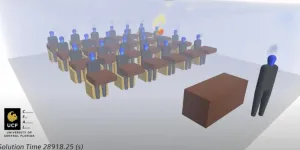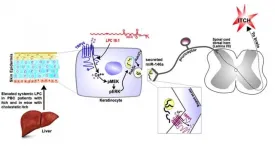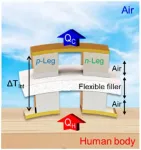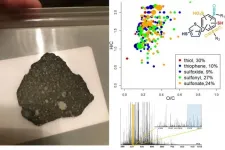(Press-News.org) ORLANDO, April 5, 2021 - A new study from the University of Central Florida suggests that masks and a good ventilation system are more important than social distancing for reducing the airborne spread of COVID-19 in classrooms.
The research, published recently in the journal Physics of Fluids, comes at a critical time when schools and universities are considering returning to more in-person classes in the fall.
"The research is important as it provides guidance on how we are understanding safety in indoor environments," says Michael Kinzel, an assistant professor in UCF's Department of Mechanical and Aerospace Engineering and study co-author.
"The study finds that aerosol transmission routes do not display a need for six feet social distancing when masks are mandated," he says. "These results highlight that with masks, transmission probability does not decrease with increased physical distancing, which emphasizes how mask mandates may be key to increasing capacity in schools and other places."
In the study, the researchers created a computer model of a classroom with students and a teacher, then modeled airflow and disease transmission, and calculated airborne-driven transmission risk.
The classroom model was 709 square feet with 9-foot-tall ceilings, similar to a smaller-size, university classroom, Kinzel says. The model had masked students -- any one of whom could be infected-- and a masked teacher at the front of the classroom.
The researchers examined the classroom using two scenarios -- a ventilated classroom and an unventilated one -- and using two models, Wells-Riley and Computational Fluid Dynamics. Wells-Riley is commonly used to assess indoor transmission probability and Computational Fluid Dynamics is often used to understand the aerodynamics of cars, aircraft and the underwater movement of submarines.
Masks were shown to be beneficial by preventing direct exposure of aerosols, as the masks provide a weak puff of warm air that causes aerosols to move vertically, thus preventing them from reaching adjacent students, Kinzel says.
Additionally, a ventilation system in combination with a good air filter reduced the infection risk by 40 to 50% compared to a classroom with no ventilation. This is because the ventilation system creates a steady current of air flow that circulates many of the aerosols into a filter that removes a portion of the aerosols compared to the no-ventilation scenario where the aerosols congregate above the people in the room.
These results corroborate recent guidelines from the U.S. Centers for Disease Control and Prevention that recommend reducing social distancing in elementary schools from six to three feet when mask use is universal, Kinzel says.
"If we compare infection probabilities when wearing masks, three feet of social distancing did not indicate an increase in infection probability with respect to six feet, which may provide evidence for schools and other businesses to safely operate through the rest of the pandemic," Kinzel says.
"The results suggest exactly what the CDC is doing, that ventilation systems and mask usage are most important for preventing transmission and that social distancing would be the first thing to relax," the researcher says.
When comparing the two models, the researchers found that Wells-Riley and Computational Fluid Dynamics generated similar results, especially in the non-ventilated scenario, but that Wells-Riley underpredicted infection probability by about 29 percent in the ventilated scenario.
As a result, they recommend some of the additional complex effects captured in Computational Fluid Dynamics be applied to Wells-Riley to develop a more complete understanding of risk of infection in a space, says Aaron Foster, a doctoral student in UCF's Department of Mechanical and Aerospace Engineering and the study's lead author.
"While the detailed Computational Fluid Dynamics results provided new insights into the risk variation and distance relationships, they also validated the more commonly used Wells-Riley models as capturing the majority of the benefit of ventilation with reasonable accuracy," Foster says. "This is important since these are publicly available tools that anyone can use to reduce risk."
INFORMATION:
The research is part of a larger overall effort to control airborne disease transmission and better understand factors related to being a super-spreader. The researchers are also testing the effects of masks on aerosol and droplet transmission distance. The work is funded in part by the National Science Foundation.
Kinzel received his doctorate in aerospace engineering from Pennsylvania State University and joined UCF in 2018. In addition to being a member of UCF's Department of Mechanical and Aerospace engineering, a part of UCF's College of Engineering and Computer Science, he also works with UCF's Center for Advanced Turbomachinery and Energy Research.
CONTACT: Robert H. Wells, Office of Research, robert.wells@ucf.edu
DURHAM, N.C. - A devastating itching of the skin driven by severe liver disease turns out to have a surprising cause. Its discovery points toward possible new therapies for itching, and shows that the outer layer of the skin is so much more than insulation.
The finding, which appears April 2 in Gastroenterology, indicates that the keratinocyte cells of the skin surface are acting as what lead researcher Wolfgang Liedtke, MD PhD, calls 'pre-neurons.'
"The skin cells themselves are sensory under certain conditions, specifically the outermost layer of cells, the keratinocytes," said Liedtke, who is a professor of neurology ...
Despite the continued development and commercialization of various wearable electronic devices, such as smart bands, progress with these devices has been curbed by one major limitation, as they regularly need to be recharged. However, a new technology developed by a South Korean research team has become a hot topic, as it shows significant potential to overcome this limitation for wearable electronic devices.
The Korea Institute of Science and Technology (KIST), or KIST, announced that a research team led by Director Jin-Sang Kim of the Jeonbuk Institute of Advanced Composite ...
A new study at Tel Aviv University reveals a possible defense mechanism developed by fireflies for protection against bats that might prey on them. According to the study, fireflies produce strong ultrasonic sounds - soundwaves that the human ear, and more importantly the fireflies themselves, cannot detect. The researchers hypothesize that these sounds are meant for the ears of bats, keeping them away from the poisonous fireflies, and thereby serving as a kind of 'musical armor'. The study was led by Prof. Yossi Yovel, Head of the Sagol School of Neuroscience, and a member of the School of Mechanical Engineering and the School of Zoology at the George S. Wise Faculty of Life Sciences. It was conducted in collaboration with the Vietnam Academy of Science and Technology (VAST). ...
Could the next Hollywood blockbuster be written by a computer? Scientists from the University of Granada (UGR) and the University of Cádiz (UCA) have designed the world's first computer system based on artificial intelligence techniques that can help film scriptwriters create storylines with the best chance of box-office success.
The researchers focused their analysis on the "tropes" of existing films--that is, the commonplace, predictable, and even necessary clichés that repeatedly feature in film plots, based on rhetorical figures. These storytelling devices and conventions enable directors to readily convey scenarios that ...
A lot of people think regret must be a good thing because it helps you not repeat a mistake, right?
But that turns out not to be the case. Not even when it comes to casual sex, according to new research from the Norwegian University of Science and Technology's (NTNU) Department of Psychology.
"For the most part, people continue with the same sexual behaviour and the same level of regret," says Professor Leif Edward Ottesen Kennair.
So, we repeat what we thought was a mistake, and we regret it just as much the next time around.
Professor Kennair and colleagues professor Mons Bendixen and postdoctoral ...
Scientists from Russia and Germany studied the molecular composition of carbonaceous chondrites - the insoluble organic matter of the Murchison and Allende meteorites - in an attempt to identify their origin. Ultra-high resolution mass spectrometry revealed a wide diversity of chemical compositions and unexpected similarities between meteorites from different groups. The research was published in the Scientific Reports.
Carbonaceous chondrites contain nearly the entire spectrum of organic molecules encountered on Earth, including nucleic acids which might have played a pivotal role in the origin of life. Since the majority of modern meteorites are of nearly the same age ...
WHO Ingrid Katz, MD, MHS, Associate Physician, Department of Medicine, Brigham and Women's Hospital; lead author of a new Perspective piece published in the New England Journal of Medicine.
WHAT While the U.S. has begun to vaccinate millions of Americans each day, COVID-19 vaccine supplies around the world remain scarce. Experts estimate that 80 percent of people in low-resource countries will not receive a vaccine in 2021. At the time of the paper's writing, the global vaccination rate was 6.7 million doses per day -- a rate at which it would take 4.6 years to achieve global herd immunity. In a new Perspective piece in the New England Journal of Medicine, Katz and colleagues highlight the need ...
A recent study of more than 2,000 companies finds that corporations feeling the pinch of financial constraints can benefit significantly from taking a more aggressive stance in their tax planning strategies. One takeaway of the finding is that tax authorities should look closely at the activities of companies facing financial constraints to make sure their tax activities don't become too aggressive.
Financial constraints aren't unusual and occur when a company can't afford to fund a project that would increase its value. Sometimes the constraints are caused by an external event - like a pandemic - that leaves companies with less income than they were anticipating. ...
Manufacturing - Mighty Mo
Oak Ridge National Laboratory scientists proved molybdenum titanium carbide, a refractory metal alloy that can withstand extreme temperature environments, can also be crack free and dense when produced with electron beam powder bed fusion. Their finding indicates the material's viability in additive manufacturing.
Molybdenum, or Mo, as well as associated alloys, are difficult to process through traditional manufacturing because of their high melting temperature, reactivity with oxygen and brittleness.
To address these shortcomings, the team formed a Mo metal matrix composite by mixing molybdenum and titanium carbide powders and used an electron beam to melt the ...
Piping plover breeding groups in the Northern Great Plains are notably connected through movements between habitats and show lower reproductive rates than previously thought, END ...







